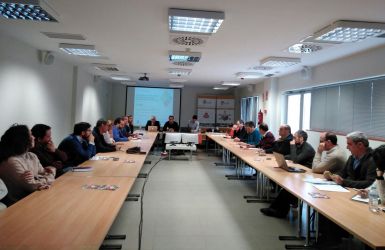The Diverfarming project maps out the most economically, socially and environmentally efficient framing practices and begins an experimental phase to offer solutions to European farmers
The olive grove, the main protagonist of Andalusian landscapes will be more profitable and will suffer fewer problems of erosion if it shares its role with other crops. Intercropping oleaginouscrops for livestock, aromatic and medicinal plants or even aloe vera between the lines of the olive groves will increase its yield. The employment that this type of growing system will generate will be key to keeping the population in rural zones and the generational change, above all in zones of mountain or slope olive groves where abandoning the land is usually more prevalent.
 These results are extracted from the second phase of the Diverfarming project, framed within the European Commission’s Horizon H2020 programme, in which a compendium of agricultural technicians, agrarian associations, political managers and final consumers have put their knowledge and experience together to find the most sustainable, profitable and environmentally-friendly crop diversification systems for each European region.
These results are extracted from the second phase of the Diverfarming project, framed within the European Commission’s Horizon H2020 programme, in which a compendium of agricultural technicians, agrarian associations, political managers and final consumers have put their knowledge and experience together to find the most sustainable, profitable and environmentally-friendly crop diversification systems for each European region.
Thyme, lavender or rosemary among the lines of the almond trees; horticultural products such as lettuce or broccoli between the fruit trees and rotations of peas with dry farming cereals finish the drawing up of the diversification map for Spain.
In Italy, the negative effects derived from monocropping are avoided with rotations of dryland cereals with broad beans and alfalfa. For irrigated cereals, tomato is chosen as the best rotation partner.
On the north of the map, in the landscapes of pasture in the Netherlands, intercropping has been assessed with wheat, broad bean, flax or oats among these pastures as the most appropriate option.
The vineyards of Germany, famous for being sown on extreme slopes, from now on will have legumes and aromatic herbs among the lines, obtaining a soil which is richer in nutrients and with “natural pesticides” thanks to the aromatic herbs.
The fruit orchards of Hungary should coexist with forage and medicinal and aromatic herbs to obtain the best benefits; the vineyards of the country should do so with mixes of legumes for livestock, oats or alfalfa. For Hungarian market gardens, however, rotation with spring barley is the system that the sectors involved in the project have determined as being the most appropriate.
Lastly, in the most northerly country considered in the study, Finland, it has been determined that introducing the rotation of legumes and cereals in the current pasture lands will maximisethe environmental and economic benefits.
Thisstructureof idealdiversificationhas been created by means of the distributionof online surveys designed and implemented by the managers of the project which is led by the Universidad Politécnica de Cartagena and in which the Universidad de Córdoba and a further 23 partners participate, including institutions, agrarian organisationsand businesses. The surveys asked the different segments involved in the project to identify the principal environmental problems to be found in the sector and the farming practices with which to resolve them.
With the intention of diffusing and enriching these results, the different partners in the project have begun a round of workdays directed at the different cogs in the agricultural chain, from research personnel right through to final consumers and passing through those that work the land.
In this line, the Council for Agricultural Research and Analysis of Agricultural Economics (CREA)in Italy, the University of Wageningen in the Netherlands and ASAJA together with the Universidad de Córdoba have already held these workdays, with the University of Trier (Germany) being incharge of closing this round of meetings on the 23rd March.
Once these systems have been assessed and consensus reached, then the phase of experimentation in the field will begin, in which the effects of the diversification will be materialised.
The diversificationof olive groves in Andalusia
The Universidad de Córdoba held its workshop on the 6thMarch in the Geolit technological park in Mengíbar (Jaen). In the workshop, the Diverfarming researchers Luis Parras and Manuel González also emphasised the environmental benefits to be gained from the project, as crops are chosen that incorporate organic matter and improve the soil properties; thus reducing the erosion so characteristic of many of these Andalusian soils.
The presence of agricultural technicians and research personnel from several institutions such as the universities of Jaen and Cordoba, the regulatory councils of the appellations of origin of Sierra de Cazorla and Sierra Mágina, IFAPA or SEO/Bird Life as well as representatives from several food cooperatives and agricultural associations have made it possible to obtain a wider view regarding the solution for the area of study and to validate the most sustainable diversification system.










